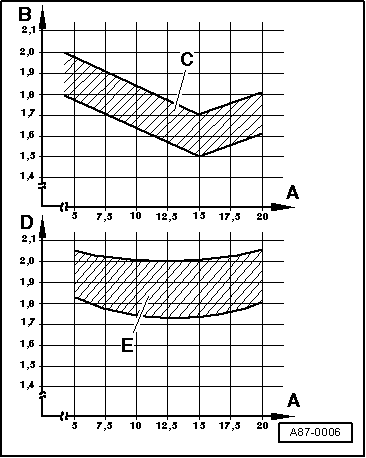Volkswagen Tiguan Service and Repair Manual: Checking with Restrictor and Reservoir, with Internally Regulated A/C Compressor
Note
- Connecting service station
- Observe test requirements
- Bring engine speed up to 2000 RPM.
- Pay attention to the A/C service station pressure gauge.
Note
- Switching pressures for refrigerant circuit switches are vehicle-specific.
- Connection with valve for low-pressure switch or at evaporator is only to be used for vehicles with no service connection on low-pressure side and inaccessible connection at compressor or accumulator (measurement accuracy). Only applies to certain vehicles.
Specified Values
High-pressure side:
Increasing from initial pressure (when connecting the pressure gauges) to a maximum of 20 bar (290 psi).
Low-pressure side:
Decreasing from initial pressure (when connecting pressure gauges) to the value in the graph.
- High pressure (measured at service connection) in bar (psi)
- Low pressure (measured at connection with valve at compressor or accumulator) in bar (psi).
- Permissible tolerance range
- Low pressure (measured at connection with valve for low-pressure switch or at service connection) in bar (psi)
- Permissible tolerance range

| Possible deviation from specification | Possible cause of fault | Corrective action |
|
Not enough refrigerant in refrigerant circuit |
|
|
||
|
Note
If no malfunction is found with this complaint, flush (clean) refrigerant circuit with refrigerant R134a. If that is not possible in this workshop, flush the refrigerant circuit with compressed air and remove moisture with nitrogen.
| Possible deviation from specification | Possible cause of fault | Corrective action |
|
A/C compressor faulty. |
|
| Possible deviation from specification | Possible cause of fault | Corrective action |
|
Constriction or obstruction in refrigerant circuit |
|
|
Moisture in refrigerant circuit |
|
|
A/C compressor faulty. |
|
Note
For the malfunction "high pressure normal, low pressure too low", note the following:
- This fault may cause the evaporator to ice up or the A/C Refrigerant Low Pressure Switch -F73- to shut off the compressor although the amount of refrigerant in the circuit is OK.
| Possible deviation from specification | Possible cause of fault | Corrective action |
|
Too much refrigerant in the circuit. |
|
| Possible deviation from specification | Possible cause of fault | Corrective action |
|
To much refrigerant oil in the circuit. |
|
|
Note
- Overfilling with refrigerant oil can occur in the event, for example, the compressor has been replaced without adjusting the quantity of refrigerant oil.
- If the A/C compressor is not replaced, the refrigerant oil should be drained from the A/C compressor via the oil drain plug. Out of the entire quantity of refrigerant oil, 50 grams should be put in the A/C compressor and the rest in the refrigerant circuit.
 Refrigerant Circuit Pressures (with A/C Service Station), Checking
Refrigerant Circuit Pressures (with A/C Service Station), Checking
Test Requirements
Note
Check cooling performance. The A/C system is functioning correctly when
the air flowing from the instrument panel vents has a temperature of 70C
or lower.
Setting on Clim ...
 Checking with Expansion Valve and Receiver/Dryer, with Internally Regulated
A/C Compressor
Checking with Expansion Valve and Receiver/Dryer, with Internally Regulated
A/C Compressor
Note
Connecting service station.
Observe test requirements.
Bring engine speed up to 2000 RPM.
Observe manometer battery.
Note
Switching pressures and design of refrigerant circuit sw ...
See More:
Volkswagen Tiguan Service and Repair Manual > Exterior Lights, Switches: High Beam Assist
General Information
Note
Familiarity with the function and operation of the headlamp assistance
is needed if there are customer concerns.
Additional information:
Refer to Owner's Manual.
Refer to Self Study Program; No 434; Headlamp Assistant.
The high beam assist turns the high beams ...
Volkswagen Tiguan Owners Manual
Volkswagen Tiguan Service and Repair Manual
- Body exterior
- Body Interior
- General Paint Information
- Paint
- Brake System
- Suspension, Wheels, Steering
- Wheel and Tire Guide
- Towing Guide
- Wheel and Tire Guide General Information
- Communication
- Electrical Equipment General Information
- Electrical Equipment from 06/2011
- Heating, Ventilation and Air Conditioning
- Refrigerant R134a Servicing
- 6-Speed Manual Transmission 02Q, OBB, and OFB
